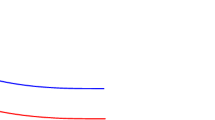Abstract
We introduce two new related metrics, the geodesic width and the link width, for measuring the “distance” between two nonintersecting polylines in the plane. If the two polylines have n vertices in total, we present algorithms to compute the geodesic width of the two polylines in O(n 2 log n) time using O(n 2) space and the link width in O(n 3 log n) time using O(n 2) working space where n is the total number of edges of the polylines. Our computation of these metrics relies on two closely related combinatorial strutures: the shortest-path diagram and the link diagram of a simple polygon. The shortest-path (resp., link) diagram encodes the Euclidean (resp., link) shortest path distance between all pairs of points on the boundary of the polygon. We use these algorithms to solve two problems:
-
Compute a continuous transformation that “morphs” one polyline into another polyline. Our morphing strategies ensure that each point on a polyline moves as little as necessary during the morphing, that every intermediate polyline is also simple and disjoint to any other intermediate polyline, and that no portion of the polylines to be morphed is stretched or compressed by more than a user-defined parameter during the entire morphing. We present an algorithm that computes the geodesic width of the two polylines and utilizes it to construct a corresponding morphing strategy in O(n 2 log2 n) time using O(n 2) space. We also give an O(nlog n) time algorithm to compute a 2-approximation of the geodesic width and a corresponding morphing scheme.
-
Locate a continuously moving target using a group of guards moving inside a simple polygon. The guards always determine a simple polygonal chain within the polygon, with consecutive guards along the chain being mutually visible. We compute a strategy that sweeps such a chain of guards through the polygon in order to locate a target. We compute in O(n 3) time and O(n 2) working space the minimum number r * of guards needed to sweep an n-vertex polygon. We also give an approximation algorithm, using O(n log n) time and O(n) space, to compute an integer r such that max(r - 16, 2) ≤ r * ≤ r and P can be swept with a chain of r guards.
Article PDF
Similar content being viewed by others
Avoid common mistakes on your manuscript.
Author information
Authors and Affiliations
Rights and permissions
About this article
Cite this article
Efrat, Guibas, Har-Peled, S. et al. New Similarity Measures between Polylines with Applications to Morphing and Polygon Sweeping. Discrete Comput Geom 28, 535–569 (2002). https://doi.org/10.1007/s00454-002-2886-1
Published:
Issue Date:
DOI: https://doi.org/10.1007/s00454-002-2886-1




